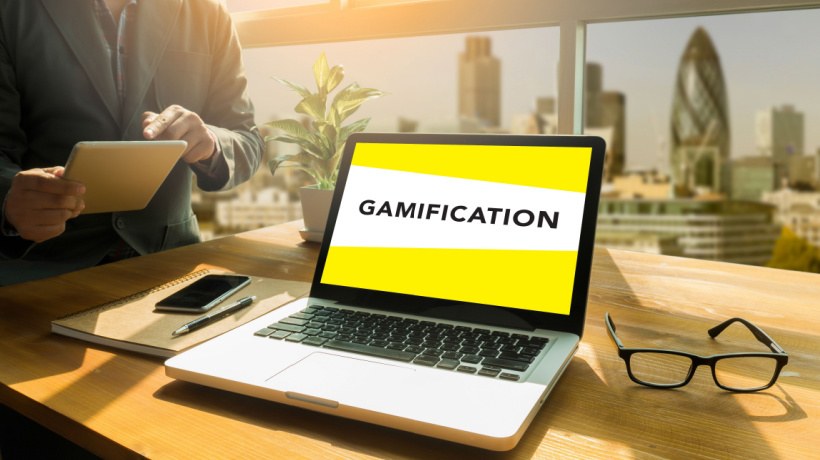Score Big With eLearning Gamification
The conventional methods of corporate training, such as distributing training manuals, playing video presentations, and conducting in-person workshops, have lost their effectiveness over time. The foremost challenge faced by Learning and Development (L&D) professionals worldwide is to enhance engagement in training programs.
This is where eLearning comes into play. It enables companies to deliver training and educational content seamlessly and at an unprecedented scale. By implementing gamification in workplace learning, which involves adding game mechanics to the Learning Management System used to deliver content, organizations can significantly boost their eLearning programs' engagement levels. This approach can help take your online learning initiatives to the next level.
eLearning Gamification: What It Is
Gamification is the practice of incorporating game-like elements into non-game settings to make them more appealing and enjoyable. These elements can include point systems, badges, leaderboards, and various levels. When done correctly, gamification can significantly improve user engagement.
For example, a coffee shop loyalty program may reward customers with points for each purchase they make, which can then be redeemed for free or discounted drinks. As customers accumulate more points, they can move up to higher tiers of membership, unlocking additional rewards and perks along the way. This can create a sense of achievement and motivate customers to continue patronizing the coffee shop.
However, it is important to note that gamification is not about creating an entire video game. Instead, it is about thoughtfully incorporating game-like elements to make the eLearning content more engaging and enjoyable for learners.
What Are The Benefits Of eLearning Gamification?
Undoubtedly, incorporating gamification into workplace learning programs offers several advantages. Here are some key benefits of using gamification in eLearning:
Gamification Promotes Skill Retention
By incorporating game-like elements such as levels, points, and badges, learners are more likely to remember and retain the material they have learned. This can lead to a better understanding of the subject and the ability to apply it in real-world situations. These features are often present in gamified learning platforms.
Gamification Enhances Feedback
Gamification in workplace learning can provide instant feedback to learners, allowing them to adjust their learning strategies and behaviors as they progress through the course. This feedback can be used to identify areas of strength and weakness, ultimately leading to better learning outcomes.
Gamification Boosts Completion Rates
By making the learning process more fun and interactive, gamification can increase learner engagement and motivation, leading to higher completion rates. When learners are invested in the learning experience, they are more likely to see it through to the end, resulting in a more knowledgeable and skilled workforce.
Gamification Allows For Personalized Learning Experiences
By incorporating game-like elements such as branching scenarios and personalized feedback, gamified learning platforms can create customized learning experiences that cater to individual learner needs. This can lead to a more efficient and effective learning process, as learners are more likely to engage with content that is tailored to their specific needs.
Gamification Can Increase Social Interaction
Gamification in workplace learning can promote social interaction and collaboration between learners, which can lead to a more engaging and effective learning experience. Elements such as leaderboards, team challenges, and group activities can encourage learners to work together and share knowledge and skills, ultimately leading to a more knowledgeable and cohesive workforce.
What Are The Disadvantages To Gamifying eLearning?
While gamification has many advantages for eLearning, there are also some potential disadvantages to consider:
- Over-gamification can distract from learning objectives
If the gamification elements are too prominent or distracting, learners may focus more on earning points and rewards rather than on the actual learning content. This can lead to a lack of understanding and retention of the material. - Poorly designed gamification can be demotivating
If the gamification elements are poorly designed or implemented, they can actually demotivate learners and reduce engagement. For example, if the rewards or points are too difficult to earn or do not feel meaningful, learners may lose interest in the course. - Gamification can be expensive to design and implement
Developing effective gamification elements can require significant resources, including time, money, and expertise. For some organizations, the potential benefits may not justify the cost. - Gamification may not be suitable for all learners
Not all learners may respond positively to gamification elements. Some may find them childish or irrelevant to their learning needs. It is important to consider the audience and tailor the gamification elements to their preferences and learning styles. - Gamification can reinforce extrinsic motivation
Gamification elements may only appeal to learners' extrinsic motivation, such as earning points or rewards, rather than intrinsic motivation, such as a genuine interest in the subject matter. While extrinsic motivation can be effective in the short term, it may not lead to long-term engagement or retention of the material.
How To Use eLearning Gamification In L&D Or Corporate Training
Gamification can be applied to Learning and Development as well, with many examples of gamification in corporate training to inspire your own program. Here are a few gamification ideas for eLearning:

What Are The Challenges To eLearning Gamification?
Here are some challenges that organizations may face when implementing eLearning gamification in workplace learning:
- Choosing the right game mechanics
With so many game mechanics to choose from, it can be challenging to select the ones that will be most effective for your eLearning content and audience. It's important to carefully consider the learning objectives and audience preferences when selecting game mechanics. - Developing effective content
Gamification should not be used to cover up poorly designed or ineffective content. The learning content must be engaging and effective on its own before incorporating game mechanics. - Balancing engagement with learning outcomes
While gamification can increase engagement, it should not distract from the primary learning objectives. The game mechanics should be used to enhance the learning experience and motivate learners toward specific learning outcomes. - Maintaining motivation and engagement
Gamification can lose its effectiveness if learners become bored or disengaged with the game mechanics. It's important to regularly update and refresh the game elements to maintain learner motivation and engagement. - Measuring effectiveness
Measuring the effectiveness of eLearning gamification can be challenging. It's important to establish clear metrics for success and regularly evaluate the effectiveness of the game mechanics in achieving the desired learning outcomes.
5 Examples Of eLearning Gamification
Leaderboards And Scorecards
Leaderboards and scorecards are tools that display the performance of learners in comparison to others.
- Why it's important
Leaderboards and scorecards are important because they motivate learners to perform better and improve their rankings. By displaying a leaderboard or scorecard, learners are more likely to strive for better performance to increase their standing. - What it brings to the table
Leaderboards and scorecards can create a sense of competition and drive amongst learners, leading to improved performance and better learning outcomes. - Why it works
Leaderboards and scorecards work by tapping into the innate desire to compete and be recognized for achievements.
For example, a course on sales training could include a leaderboard showing the top performers based on their sales numbers.
Badges And Achievements
Badges and achievements are digital representations of learners' achievements that can be awarded upon completing objectives or achieving goals.
- Why it's important
Badges and achievements are important because they provide learners with tangible rewards for completing objectives and achieving their goals, which can motivate them to continue learning and growing. - What it brings to the table
Badges and achievements can incentivize learners to complete courses and master content that may otherwise be perceived as uninteresting or irrelevant. - Why it works
Badges and achievements provide a sense of accomplishment and recognition, motivating learners to continue learning and striving toward their goals.
For example, a compliance training course could award badges for completing modules and achieving a certain score on the final assessment.
Interactive Scenarios And Simulations
Interactive scenarios and simulations are digital environments that allow learners to interact with simulated situations and apply their knowledge.
- Why it's important
Interactive scenarios and simulations are important because they provide learners with a hands-on learning experience that is engaging and memorable, leading to better retention and application of the content. - What it brings to the table
Interactive scenarios and simulations can help learners to apply their knowledge and practice their skills in a safe and controlled environment, leading to better learning outcomes. - Why it works
Interactive scenarios and simulations work by engaging learners through the experiential learning process, allowing them to make mistakes and learn from them in a low-risk environment.
For example, a course on customer service could include a simulation where learners interact with virtual customers and resolve their issues.
Gamified Assessments
Gamification ideas for eLearning include incorporating gamified assessments. These assessments utilize game-like elements like points, levels, and rewards to make the assessment experience more engaging and interactive.

- Why it's important
Gamified assessments are important because they can make assessments more engaging and less intimidating, leading to better learning outcomes. - What it brings to the table
Gamified assessments can incentivize learners to take assessments more seriously and can provide a sense of achievement and accomplishment upon completion. - Why it works
Gamified assessments work by making the assessment process more enjoyable and engaging, tapping into the desire for achievement and progress.
For example, a course on cybersecurity could include a quiz game where learners answer questions to earn points and progress to higher levels.
Storytelling And Game-Based Learning
Storytelling and game-based learning are approaches that use elements of storytelling and gameplay to create engaging learning experiences.
- Why it's important
Storytelling and game-based learning are important because they can create immersive and engaging learning experiences that teach skills and concepts in a fun and memorable way. - What it brings to the table
Storytelling and game-based learning can help learners understand complex topics and apply their knowledge practically. - Why it works
Storytelling and game-based learning work by engaging learners through the use of relatable narratives and challenges, leading to better retention and application of the content.
For example, a course on leadership could use a role-playing game where learners take on the role of a leader and make decisions that impact their team and organization.
What Is The Future Of eLearning Gamification?
The future of eLearning gamification looks promising, as it continues to evolve and adapt to the changing needs of learners and organizations. Here are some trends that are shaping the future of gamification in workplace learning:
- Personalization
eLearning gamification is becoming more personalized, with the use of adaptive learning algorithms that can adjust the difficulty level and content of the course based on learners' individual needs and preferences. - Immersive experiences
With the advent of Virtual and Augmented Reality technologies, eLearning gamification is becoming more immersive, providing learners with realistic and engaging learning experiences. - Data analytics
The use of data analytics is becoming increasingly important in eLearning gamification, as it allows organizations to track learner progress and measure the effectiveness of the gamification elements. - Microlearning
eLearning gamification is also becoming more focused on microlearning, with short and bite-sized modules that are easier for learners to complete and retain. - Social learning
eLearning gamification is leveraging the power of social learning, with features such as social sharing, team challenges, and leaderboards on gamified learning platforms that promote collaboration and engagement among learners.
When exploring gamification ideas for eLearning, partnering with a top-notch gamification provider can truly level up your program and deliver an engaging, immersive experience for your learners. With their expertise and experience, they can design and deliver a gamified eLearning solution that not only aligns with your training goals but also leverages the psychology behind gamification. By collaborating with a trusted provider, you can unlock the full potential of gamification and create a transformative learning experience for your audience.
With a range of tools and platforms such as an authoring tool, a Learning Management System, and virtual classroom software, a good provider can help you create a fun and effective training program that improves learner engagement and retention. Trust a good provider to help you achieve your training goals and deliver tangible results for your organization.
Image Credits:
- The images within the body of the article were created/supplied by the author.










